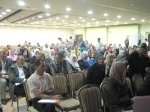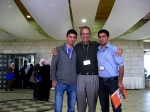 In last week’s post I identified some of the tensions that characterize the current state of ELT, the resolution of which may determine the shape that the profession takes in the next decade or two. Without daring to commit to an outcome, one way or the other, let me suggest two more dimensions along which the future of ELT may be inscribed.
In last week’s post I identified some of the tensions that characterize the current state of ELT, the resolution of which may determine the shape that the profession takes in the next decade or two. Without daring to commit to an outcome, one way or the other, let me suggest two more dimensions along which the future of ELT may be inscribed.
- The tension between public and private
Most English language teaching, and specifically EFL, takes place in public institutions, such as state-funded schools or universities. In these contexts, ELT methodology is typically (but not always) constrained by such factors as class size, i.e. large numbers of learners often seated in rows; limited contact with the target language; teachers who are less that fully confident in their own command of English (even if they are expected to use it as the vehicular language in their classes); a lack of motivation on the part of the learners; and mandated curricula that are driven by exams whose focus is primarily on accuracy. Under such conditions it is not surprising that the favoured methodology is form-focused, teacher-fronted, choral, and bilingual – a variant, in other words, of grammar-translation.
In the private (or fee-paying) sector, however, things tend to be very different: with smaller class-sizes and (often) native-speaker teachers – or, even, only native-speaker teachers – albeit with minimal training. Learners may be there of their own volition, motivated by work, study, or leisure-related needs. Such an ‘ecology’ favours a more learner-centred, English-only and activity-based methodology – a variant, in other words, of communicative language teaching.
 It’s likely that this division will persist for the foreseeable future, particularly in developing countries, which do not have the means to support ongoing professional development of state-school teachers, but where the necessity of having ‘English’ somewhere on the curriculum will long outlive its utility. Meanwhile, attempts to redress the generally poor results in the public sector by introducing English-medium instruction (e.g. in the form of CLIL) will work only when both teachers and learners have a ‘critical mass’ of English language proficiency to support content-based learning without prejudicing the learning of the subject matter. In some contexts, this may still be generations away. Until then, any form of immersion is likely to be associated with the elite, private sector.
It’s likely that this division will persist for the foreseeable future, particularly in developing countries, which do not have the means to support ongoing professional development of state-school teachers, but where the necessity of having ‘English’ somewhere on the curriculum will long outlive its utility. Meanwhile, attempts to redress the generally poor results in the public sector by introducing English-medium instruction (e.g. in the form of CLIL) will work only when both teachers and learners have a ‘critical mass’ of English language proficiency to support content-based learning without prejudicing the learning of the subject matter. In some contexts, this may still be generations away. Until then, any form of immersion is likely to be associated with the elite, private sector.
Indeed, the public-private polarity both reflects and intensifies existing inequalities and does not look like improving any time soon. As Bruthiaux (2002, p. 190) comments, ‘In most markets, the consumers of English language education are the relatively well-off, already far beyond the stage of mere survival. To the extent that the severely poor are aware of it at all, the global spread of English is a sideshow compared with the issue of basic economic development and poverty reduction.’
- The tension between ‘standard English’ and English as a lingua franca
For the original proponents of the communicative approach it was axiomatic that native-like competence was a less urgent and less realistic goal than communicative efficiency, particularly with regard to pronunciation. In theory, at least, a first language accent was tolerable so long as it was intelligible. Such generosity did not readily extend to other systems, such as grammar, which were still taught and tested according to some idealized notion of what a native-speaker might say or write. This ‘native speakerism’ was reinforced by the prestige still being bestowed on native speaker teachers, especially in the private sector (see above). As long ago as 1999, Vivian Cook railed against this deficit model of instruction, arguing that ‘L2 users have to be looked at in their own right as genuine L2 users, not as imitation native speakers’ (1999, p. 195).
This view was given extra impetus by the realization that, for many users, English is a contact language between other English-as-an-L2 users, and that, therefore, different standards apply. The notion of English as a lingua franca (ELF) as promulgated by Jennifer Jenkins (2000) – initially in relation to phonology – had the effect (or should have had the effect) of moving the goalposts in the direction of the learner-user. Nevertheless, years of (often bitter) debate have not resolved the issue as to what the goalposts actually look like. Is there an emergent codifiable variety called ELF? Or is it simply an elusive social practice – a spontaneously negotiated communicative ‘dance’ involving a creative mix of pragmatics, paralinguistics, accommodation, code-switching, repair strategies and interlanguage?
 Either way, the effect has been to challenge, even subvert, the supremacy of the native-speaker ‘gold standard’. Will the steady penetration of English into all corners of the globe and at most levels of society, mediated by ever swifter, cheaper and more accessible technologies, do the rest? Or will the need for some mutually intelligible ‘common core’ tip the argument in favour of retaining the Queen’s English (or a version thereof)? The jury is out.
Either way, the effect has been to challenge, even subvert, the supremacy of the native-speaker ‘gold standard’. Will the steady penetration of English into all corners of the globe and at most levels of society, mediated by ever swifter, cheaper and more accessible technologies, do the rest? Or will the need for some mutually intelligible ‘common core’ tip the argument in favour of retaining the Queen’s English (or a version thereof)? The jury is out.
I had promised to discuss three ‘tensions’ today, but I am already out of time. Will there be more Predictions? Place your bets!
References
Bruthiaux, P. (2002) ‘Hold your courses: language education, language choice, and economic development.’ TESOL Quarterly, 36/3.
Cook, V. (1999) ‘Going beyond the native speaker in language teaching.’ TESOL Quarterly, 33/2.
Jenkins, J. (2000). The phonology of English as an international language. Oxford: Oxford University Press.







Recent comments